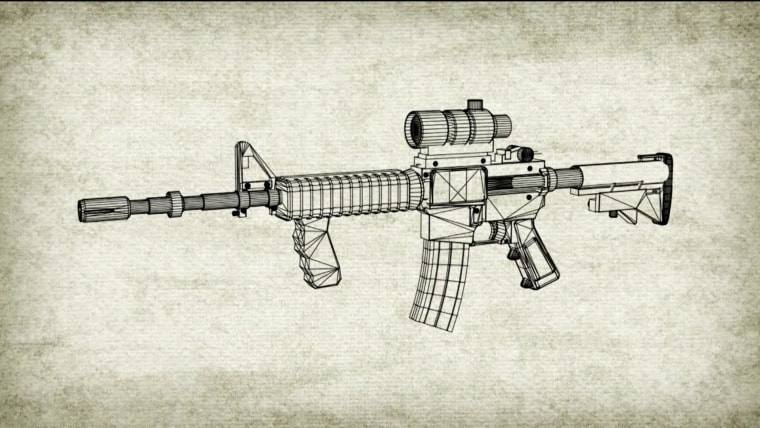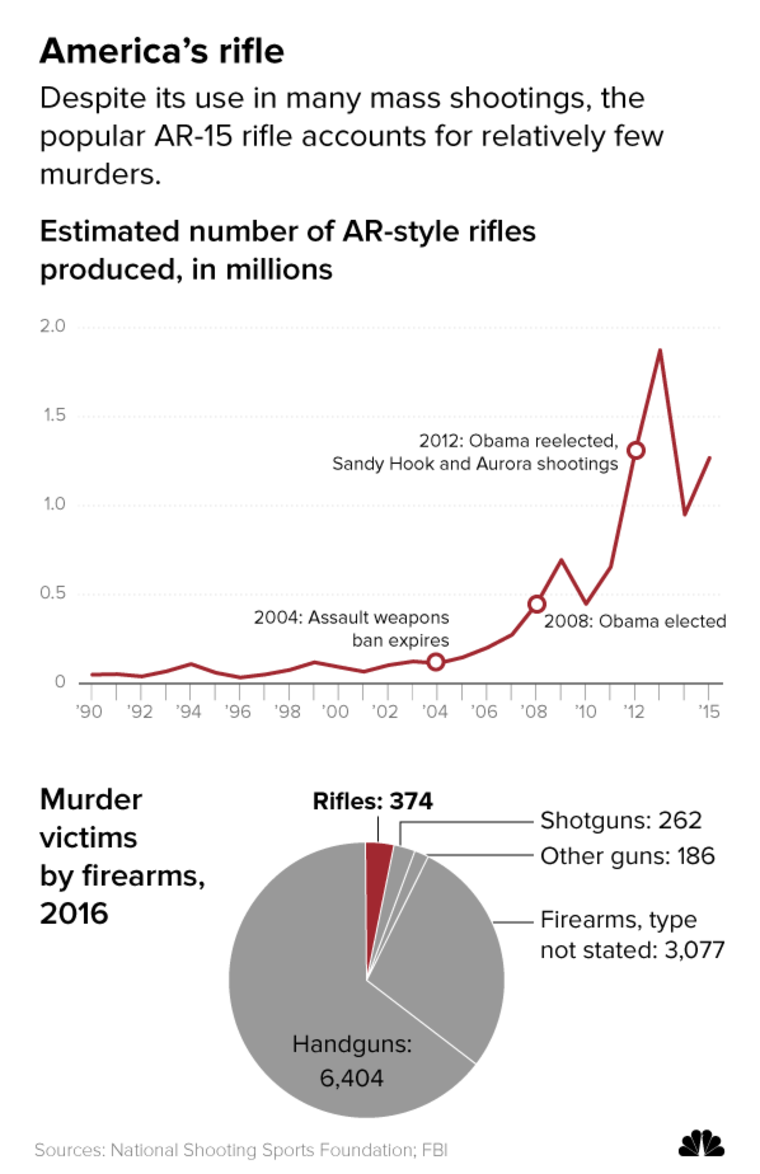Colt Ar 15 Mod Le 6941 Reviews and Videos
UPPER MARLBORO, Md. — There are a lot of reasons people love their AR-fifteen semiautomatic rifles, and it doesn't much matter to them what the haters say.
For some, the gun is a tool, a finely tuned machine that can cut down an brute or intruder, or pierce a distant target, with a single precise shot.
For others, it is a toy, a sleek beast of black plastic and metal that delivers a gratifying blast of adrenaline.
And for many, it is a symbol, the embodiment of cadre American values — liberty, might, self-reliance.
"There are very few things that serve such a groovy course and office, and look cool," said Daniel Chandler, 26, an AR-15 owner here in suburban Maryland. When he takes his AR out of its case at a shooting range, he smiles like he just unwrapped a gift. "There are few things you'll find that are wonderfully highly-seasoned to look at, wonderful exercises in mechanical applied science, and that could save your life."
This is the side of the AR-xv that many don't see, or ever consider.
Considering an AR-15, or a variant, was reportedly used in several mass shootings — including Aurora, Colorado; Newtown, Connecticut; San Bernardino,California; Sutherland Springs, Texas; Las Vegas and Parkland, Florida, in which a full of 154 people were killed — this noncombatant sibling of a military assault rifle is an exceptionally polarizing product of modern American industry. The AR-xv and its semiautomatic cousins — they shoot ane round for each pull of the trigger ─ incite repulsion among those who run across them equally excessive, grotesque and having no place on the civilian market.
Information technology is the focus of multiple attempts at prohibition, which in turn has prompted people to run out and purchase more. Such "panic buying" drove sales of AR-15s to tape levels during the presidency of Barack Obama and the 2016 presidential entrada. Gun merchants say some buyers are also driven by a fascination with a weapon used in notoriously heinous crimes.

Fears of a ban have subsided under gun-friendly President Donald Trump, and so have sales; gun makers are in the midst of a twelvemonth-long slump that has driven down prices for AR-style rifles. Those discounts appear to have driven a record number of Blackness Friday gun background checks.
Devotees say the AR-15 has been wrongly demonized, arguing that the vast majority of owners never utilize it in a crime, and that despite the rifle's use in mass shootings, information technology is responsible for a very small proportion of the country's gun violence.
Thanks to that ardent following, and shrewd marketing, the AR-fifteen remains a gem of the gun manufacture, the country's most pop rifle, irreversibly lodged into American culture.
From Vietnam to the mainstream
The AR-fifteen was developed in the late 1950s as a noncombatant weapon by Eugene Stoner, a old Marine working for small California startup called ArmaLite (which is where the AR comes from). The gun, revolutionary for its low-cal weight, like shooting fish in a barrel care and adaptability with additional components, entered the mainstream in the mid-1960s, afterwards Colt bought the patent and adult an automatic-fire version for troops in Vietnam, called the M16.
The civilian model wasn't mass produced until the 1980s, later the original patent expired and a variety of companies began making them. That transformed a specific brand to a more than generic offering on which a mini-industry would flourish.
When the AR-15 and other semiautomatic rifles began to plow up in shootings, a movement began to restrict their manufacture and auction. Much of the outrage stemmed from the militaristic advent of those guns, and their ability to burn down rapidly.
But there was also a more visceral reason, involving flesh and claret. AR-15s inflict much more than impairment to human tissue than the typical handgun, which is used in most shootings. That's largely because of the speed at which projectiles exit the weapons; they are much faster out of the cage of an AR-15, or similar rifle, and deliver a more devastating blow to bones and organs. Those projectiles are also more than likely to break apart as they pass through the body, inflicting more harm.
"The higher cage-velocity projectiles, if they strike an organ, you're more likely to take severe injury and bleeding and dying than with lower cage-velocity munitions," said Donald Jenkins, a trauma surgeon at the University of Texas Health Science Middle at San Antonio and the possessor of several guns, including an AR-15.
The backlash peaked in 1994, when President Beak Clinton signed a ban on the sale of many types of semiautomatic rifles deemed "assault weapons," including versions of the AR-15. Manufacturers continued making versions of the AR-15 that complied with the new law, which was allowed to expire in 2004. That set the stage for an explosion in AR-15 sales.
Past then, military-manner weapons were becoming a more common sight in America, due largely to the response to the 9/11 attacks. Anti-terror police forces began patrolling cities and transportation hubs, and the wars in Afghanistan and Iraq were covered intimately. That higher visibility seemingly fed a desire among gun owners to get what the troops and cops were using.
With encouragement from the gun industry, the AR-xv grew popular not merely among people who enjoyed owning the latest tactical gear, but as well amongst recreational and competitive target shooters, and hunters. Many saw it as a pinnacle of firearms engineering — ergonomic, accurate, reliable.

"Information technology'southward kind of the standard, de-facto rifle at present," said Evan Daire, 23, a gun-range worker in New Bailiwick of jersey who aspires to go a professional person target shooter. "No matter what function you're looking at, it pretty much fills that part."
Product of AR-mode guns has soared since the federal ban expired. In 2004, 107,000 were fabricated. In 2015, the number was one.2 million, according to the National Shooting Sports Foundation (NSSF), an industry trade association. The organisation does non provide sales data, nor does it accept 2016 product estimates, merely says that year'due south activity likely broke all records.
Today, 1 of out of every 5 firearms purchased in this country is an AR-style rifle, according to a NSSF estimate. Americans now own an estimated 15 million AR-15s, gun groups say. New AR-15 fashion guns range widely in price, from about $500 to more than $2,000.
'Destined to be a best-seller'
Chandler is an unlikely AR enthusiast. He grew up exterior Baltimore, a city plagued past gun violence, raised by parents opposed to firearms and was friends with kids whose lives had been torn apart by them. For much of his youth he considered himself anti-gun.
Then a well-to-do neighbour was shot in a home invasion. Chandler realized that his family unit had no weapon to defend itself, and decided to buy a gun when he got old plenty.
Source: https://www.nbcnews.com/news/us-news/america-s-rifle-why-so-many-people-love-ar-15-n831171
0 Response to "Colt Ar 15 Mod Le 6941 Reviews and Videos"
Post a Comment